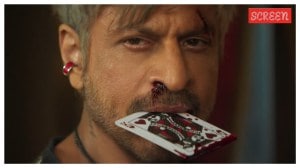Local area network
Our first stop is the All India Radio (AIR) office in Indore, since the station maintains an extensive database of folk musicians. The offic...

Our first stop is the All India Radio (AIR) office in Indore, since the station maintains an extensive database of folk musicians. The officials there are a little wary of the two people standing before them—a 34-year-old entrepreneur and a journalist. After all, they don’t expect out-of-towners to just land up one day at Malwa House and start enquiring about folk music. But Shefali Bhushan, one of four partners who run beatofindia.com, a website dedicated to folk music, is used to cold calls.
Bhushan scouts for untapped potential by combing the countryside and records them live on an IBM laptop connected to four low sensitive mics. An analog to digital mixer then uploads them onto the website. This time she intends to record the folk music of the Malwa belt. We primarily set out in search of Kabir panthis (Sant Kabir’s followers who sing songs set to his verse) but also come across Sunderakhand singers and Sant Singhaji worshippers.
The AIR officials slowly warm up to Bhushan. Geeta Markaam, a senior executive, knows the artistes Bhushan is looking for and helps us with references and contacts.
An hour later, with Malwi in the not-found list, we drive past fields of soya, towards Ujjain, 56 km away. Sunderlal Malwi is waiting for us at singer Archana Parmar’s residence.
A troupe of musicians, including a dholak vadak and a tabla player (who’s running a fever), rise to greet us. Malwi is a 38-year-old full-time musician, with a Bachelor’s degree in vocal music. But both his and Archana Parmar’s performances fall a little below my expectations. Shankariya, a throaty, pacy love song, which originated at the Rajasthan-Malwa border and usually sung during local fairs, is Malwi’s best rendition. ‘‘I’ve even done ghazals before, but my soul is in folk,’’ he says.
Parmar’s voice sounds more suited for playback, and she renders folk in a light, ghazal style. Too polished, maybe they will make it to a compilation album. He might have a full web page to his credit, but he’s nothing like Swarn Noora, the voice that first led me to establish contact with Bhushan.
It’s almost 8.00 pm when we leave, but the day hasn’t ended yet. We’re driving back to Indore. Bheru Singh Chauhan of Bajrang Pura village in Mahu district has been lined up next. The journey over unlit, mud tracks takes over an hour.
The scrawny men with bright headgear are edgy, under the harsh glare and heat produced by a single halogen. There are two lead vocalists, including Chauhan’s elder brother, and we realise that today’s last act is as authentic as it gets.
They open the performance with Maara Mandariya Mein Aap Padharo Ganpati in praise of the elephant god, moving on to Kabir bhajans such as Aaj Anand Yahaan Bhaayo Angna Mein as a mark of welcome. The manjira (cymbal) player—eyes shut, hands swinging in wide arcs and upper body swaying lazily—appears to be in a trance.
A little later, we ask Chauhan why his group doesn’t have female performers. ‘‘Here we don’t even sit with our wives in front of our elders,’’ replies Chauhan, a little shocked at our question. There goes the global village theory, and so what if there’s cellphone connectivity.
The first track Pyaaro Laage Re Maaro Malwo Des knocks the wind out of me. Dandiya queen Falguni Pathak has ripped this one off for her Maaro Ghaagro Re. The originals keep coming at you.
A wedding song, traditionally sung by a girl who awaits the arrival of her brother, called Gaadi Jo Radki Ret Me Beera inspired Pathak’s Chudi Jo Khanki Haath Mein. Remember the music video that featured Riya Sen?
Another number based on Kabir’s verse—Taari Vachan Si Kaaya Ko Bharosa—distinctly sounds like one of Pathak’s earliest hits—Maine Payal Jo Khankayee (the puppet music video).
When we tell the group about it, they’re not surprised. ‘‘Yeh copy karte rehte hain,’’ says Rajkumar, Akhand’s 35-year-old son, who sings and plays the manjira.
‘‘Father has been performing these traditional songs for AIR for the past 40 years,’’ adds Rajkumar, an accountant by profession. His elder brother Rakesh also accompanies Akhand on the tabla. ‘‘My colleagues are happy that I’m an artiste and let me off whenever I have a rehearsal or a show,’’ explains the 36-year-old electrical engineer.
We pass by vendors seated on the ground, who fan mounds of burning coal placed next to bouquets of golden corn in cane baskets. We have to stop for some mouth-watering bhutta. Our main local resource person Dinesh Sharma tells us how the monsoons haven’t visited this year, so the corn isn’t as juicy. We’re not complaining.
We’re driving back to Indore to a village called Dakachya, where we are met by a group headed by Makhanlal Chowdry. The average age of the group is 50. The witty, elderly men flock together in an unfinished brick and cement structure next to a Sant Singhaji temple. Singhaji was born 400 years ago, and has been an important influence on religious folk music in Malwa. The singers belong to a group that was formed 100 years ago.
The room’s grey ceiling has wires criss-crossing each other like kite threads. But there’s no electricity in the building. Bhushan backs up on battery, as the men, who are divided into two groups of three vocalists and two accompanists, launch into an energetic santvaani. There is a fair amount of petty bickering in the group, concerned with who should lead the vocals, and some shushing when curious little boys noisily scuttle into the room.
The performance is accompanied by manjiras and a percussion instrument called the chota mridang or a small mridangam, which is padded with wheat flour on one side and coated in black dye on the other.
After six songs, which include some written by Dalu Das, Sant Singhaji’s favourite disciple, Bhushan records the group with her handycam.
The man we meet in the evening is the finest Kabir panthi I’ve heard so far. Prahlad Singh Tipanya is my journey’s destination.
Peerless in vocal quality as well as composition, Tipanya and his five-string tambur (don’t mistake this for the tanpura, this instrument, when strummed hard, sounds suspiciously like a guitar) have travelled through the West Coast. ‘‘California, Santa Berra, Los Angeles,’’ rattles 54-year-old Tipanya.
‘‘I first heard a peasant song based on Kabir’s verse in a village called Gorkhedi in 1975,’’ recalls Tipanya. ‘‘I had to sing along, the voice came from somewhere within me.’’ His face doesn’t contort and there are no histrionics when he sings with his eyes shut. He devotes all the emotion to his vocals.
When Tipanya sings Gaadi Maari Rang Rangeeli, Paiyan Hain Laal Gulaal, the simplicity of the lyrics, much like any other work of Kabir, fills up your senses.
Their guru Hira Singh Borliya, a volatile old man, appears to be one of the few singers who can exploit the female singing scale effortlessly. ‘‘Why should the gents have monopoly?’’ asks Vyas, adjusting her spectacles.
The group swings between regular cheerful wedding style songs and short bhajans. The women grin and sometimes laugh out loud when Borliya tries to crack the whip.
Keeping in mind the Chauhans of Bajrang Pura and the Chowdrys of Dakachya, this part of India is making some equal music.
- 01
- 02
- 03
- 04
- 05





























